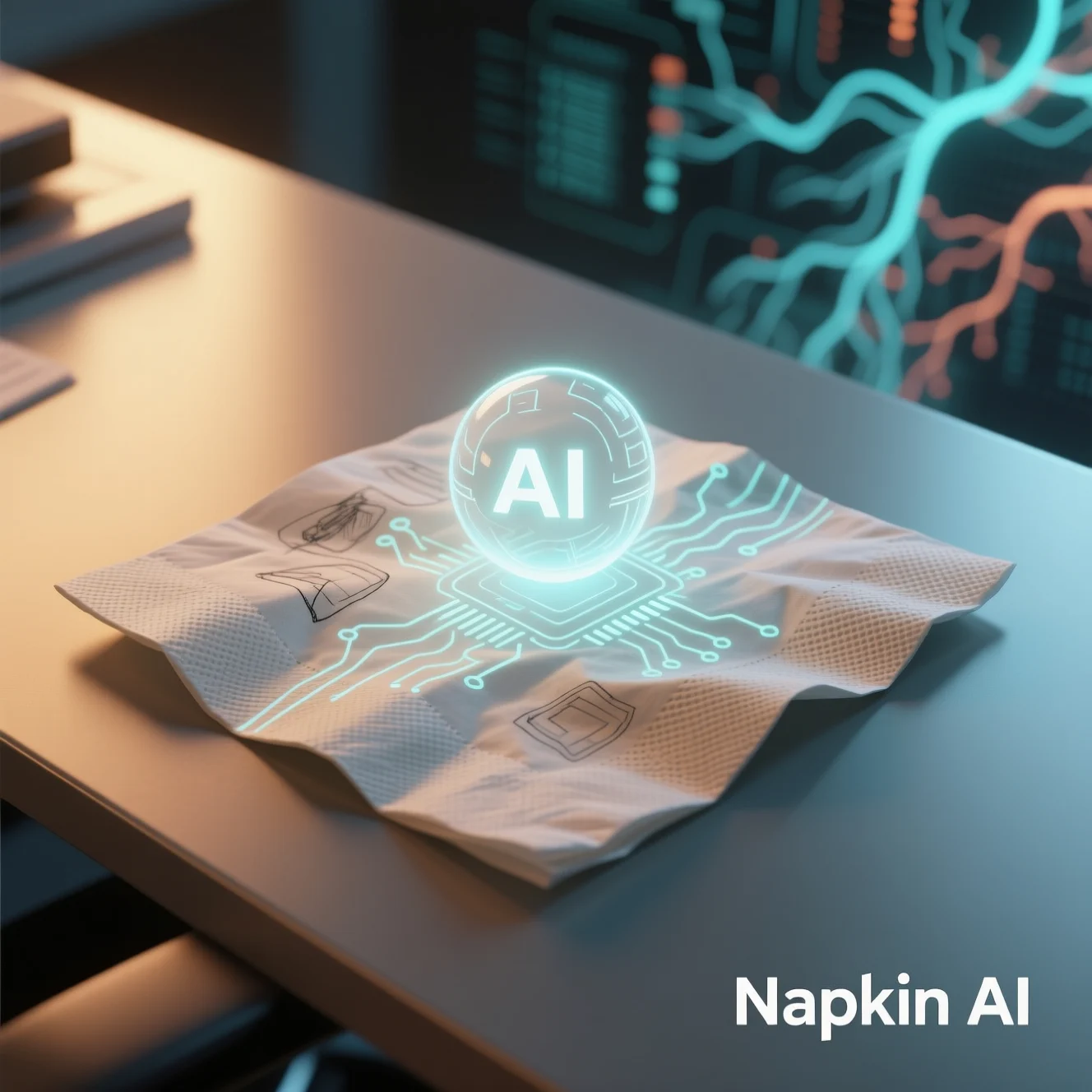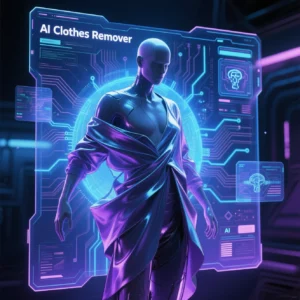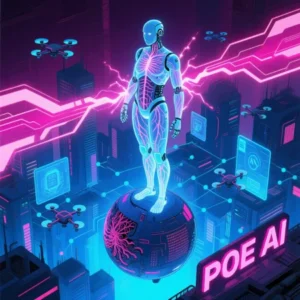Why Visuals Matter in Today’s Communication
Picture this: you’re pitching a business idea, but your audience’s eyes glaze over at your text-heavy slides. Sound familiar? Visuals grab attention and make ideas stick. Studies show that posts with images get up to 650% more engagement than text alone. Yet, creating AI diagrams or infographics often feels like wrestling with complex design software.
That’s where Napkin AI swoops in, turning your text into visuals with a single click. This blog post unpacks everything you need to know about Napkin AI—its features, use cases, and why it’s a must-have for visual communication. By the end, you’ll be ready to create stunning AI-powered visuals that elevate your work.
What Is Napkin AI?
Napkin AI is a visual AI tool that transforms plain text into professional diagrams, flowcharts, infographics, and mind maps. Founded by Pramod Sharma and Jerome Scholler, who previously built the AI gaming company Osmo, Napkin AI was born from a frustration with dull, text-heavy documents. Their mission? To make visual storytelling accessible to everyone, no design skills required. Currently in its beta phase, Napkin AI offers a free plan with 500 weekly AI credits, letting users experiment with its text-to-visual magic on desktop browsers.
- Core Functionality: Converts text into visuals like flowcharts, mind maps, or infographics.
- Founders’ Vision: Inspired by making learning fun, they aimed to simplify business communication.
- Accessibility: Free beta plan, no design expertise needed, desktop-focused.
“Napkin AI generates exactly what I need in seconds, like having a designer at my fingertips.” – Jason Miller, COO of SproutsAI Inc.
How Napkin AI Works: From Text to Stunning Visuals
Creating visuals with Napkin AI is as easy as brewing your morning coffee. You don’t need to be a design wizard or craft fancy prompts. Here’s how it turns your text into AI diagrams or infographics in seconds:
- Input Text: Paste or type your content—think meeting notes, blog outlines, or business processes.
- AI Analysis: Napkin AI’s natural language processing (NLP) engine scans your text, identifying key ideas and relationships.
- Visual Generation: Click the “Spark” icon to generate multiple visual options, like flowcharts or mind maps.
- Customization: Tweak colors, fonts, icons, or layouts to match your style or brand.
- Export or Share: Save as PNG, SVG, PDF, or PPTX, or share via a link for team collaboration.
For example, imagine you’re a project manager with a dense paragraph about a new workflow. Paste it into Napkin AI, hit “Spark,” and voilà—a clear flowchart generator produces a visual in under 30 seconds. It’s that simple!
- Time-Saving: Generates visuals faster than manual design tools.
- No Prompt Engineering: Unlike other AI tools, Napkin AI doesn’t require complex instructions.
- Flexible Outputs: Choose from various formats to suit your needs.
Key Features of Napkin AI
Napkin AI packs a punch with features that make visual communication effortless. Here’s a breakdown of what sets it apart:
- Text-to-Visual Transformation: Converts text into AI diagrams, infographics, or mind maps without manual design work.
- Customization Options: Adjust colors, fonts, icons, and connectors to align with your brand’s style.
- Real-Time Collaboration: Edit and comment with teams, like working in Google Docs.
- Export Flexibility: Supports PNG, SVG, PDF, and editable PPTX for seamless integration into presentations or reports.
- Extensive Icon Library: Access thousands of icons to enhance visual appeal.
- Multilingual Support: Generates visuals in over 60 languages, matching your input text.
- Intuitive Interface: Designed for beginners and pros, with no steep learning curve.
Recent updates (as of August 2025) include new fonts like M PLUS Rounded 1c and Noto Serif Japanese, a color picker for custom fills, and enhanced export options with real-time previews. These additions make Napkin AI a powerhouse for infographic creation.
| Feature | Description | Benefit |
|---|---|---|
| Text-to-Visual | Converts text to diagrams or infographics | Saves hours of manual design work |
| Customization | Edit colors, fonts, icons, and layouts | Ensures brand consistency |
| Collaboration | Real-time editing and commenting for teams | Streamlines team workflows |
| Export Options | PNG, SVG, PDF, PPTX formats | Fits into any project or platform |
| Multilingual Support | Works in 60+ languages | Reaches global audiences |
Who Can Benefit from Napkin AI?
Napkin AI is a Swiss Army knife for anyone who communicates ideas. Here’s who it’s perfect for, with real-world examples:
- Business Professionals: Create pitch decks, reports, or client visuals that impress. A consultant used Napkin AI to map a client’s supply chain into a flowchart, winning over stakeholders in minutes.
- Educators and Trainers: Turn lesson plans or training materials into engaging AI diagrams. A history teacher visualized a timeline of World War II events, making it easier for students to follow.
- Content Creators: Boost blogs, social media posts, or newsletters with infographic creation. A marketer turned a blog outline into a LinkedIn infographic, doubling engagement.
- Entrepreneurs: Visualize business plans or customer journeys for clarity. A startup founder created a revenue stream diagram for a pitch deck, securing $50,000 in funding.
However, Napkin AI isn’t ideal for data visualization specialists needing complex charts from specific datasets. For those, tools like Tableau or Power BI might be better.
- Notable Users: Project managers, marketers, teachers, bloggers, and small business owners.
- Key Advantage: Simplifies complex ideas into visuals anyone can understand.
Why Napkin AI Stands Out
In a sea of design tools, Napkin AI shines for its text-to-diagram focus. Let’s compare it to competitors like Canva, Lucidchart, and Miro:
- Vs. Canva: Canva offers broad design capabilities, but Napkin AI automates visual storytelling from text, cutting design time significantly.
- Vs. Lucidchart: Lucidchart excels at technical diagrams but requires manual setup. Napkin AI’s AI-driven approach is faster for non-experts.
- Vs. Miro: Miro is great for collaborative whiteboards, but Napkin AI focuses on structured AI-powered visuals from text.
Napkin AI’s edge lies in its simplicity and automation. You don’t need to fiddle with templates or align shapes manually—its NLP engine does the heavy lifting. Plus, its free beta plan (with 500 weekly AI credits) and $10M seed funding from Accel and CRV signal a bright future with more features on the way.
| Tool | Strength | Weakness | Best For |
|---|---|---|---|
| Napkin AI | Fast text-to-visual automation | Limited mobile editing | Quick visuals from text |
| Canva | Polished slides and templates | Manual design work | General graphic design |
| Lucidchart | Complex technical diagrams | Steep learning curve | Engineering diagrams |
| Miro | Collaborative whiteboards | Less focus on structured visuals | Team brainstorming |
“Napkin AI is a game-changer for anyone who wants to communicate ideas clearly without spending hours on design.” – Sarah Lee, Marketing Director
Practical Tips for Maximizing Napkin AI
Want to get the most out of Napkin AI? Here are some insider tips to create stunning AI diagrams and infographics:
- Keep Text Concise: Short, clear sentences produce cleaner visuals. Avoid jargon-heavy paragraphs for best results.
- Experiment with Formats: Try different outputs (e.g., flowchart vs. mind map) to find what best conveys your idea.
- Leverage Branding: Use custom colors and fonts to align visuals with your brand’s identity.
- Combine with Text: Pair Napkin AI visuals with text in reports or blogs for a cohesive story.
- Regenerate Options: If the first visual isn’t perfect, click “Spark” again for new layouts.
For example, a blogger used Napkin AI to create a comparison table for a product review, making it easier for readers to skim key points. This boosted time-on-page by 25%.
- Pro Tip: Highlight specific text sections and use the “Spark” icon to generate visuals for just that part.
- Collaboration Hack: Share links with team members to gather feedback in real-time.
Real-World Success Stories
Napkin AI isn’t just a tool—it’s a productivity booster. Here are three real-world examples showcasing its impact:
- Project Manager’s Win: A project manager condensed a seven-paragraph slide about a software rollout into a single flowchart. The visual clarified the process, earning praise from her team and speeding up approval.
- Teacher’s Triumph: A high school teacher turned a lesson plan on ecosystems into a mind map. Students found it easier to grasp food chain relationships, with 80% reporting better understanding.
- Startup Success: An entrepreneur visualized customer acquisition channels for a pitch deck. The clear infographic helped secure $100,000 in seed funding from investors.
These stories highlight how Napkin AI turns complex ideas into visual frameworks that resonate.
“I’m obsessed with Napkin AI. It’s intuitive and saves me hours of design work!” – Emily Chen, Content Creator
Limitations and Considerations
No tool is perfect, and Napkin AI has a few quirks to keep in mind:
- Desktop-Only Editing: As of August 2025, full editing is limited to desktop browsers. Mobile users can view but not create or edit visuals.
- Not for Complex Data: Napkin AI excels at structured text but struggles with intricate datasets requiring specific charts (e.g., statistical graphs).
- Beta Phase Glitches: Occasionally, visuals may seem simplistic or slightly off-topic, but regenerating options usually fixes this.
- Future Paid Plans: While the beta is free, premium features like advanced templates may require a subscription post-beta.
Despite these, Napkin AI’s simplicity and free plan make it a low-risk tool to try.
| Limitation | Impact | Workaround |
|---|---|---|
| Desktop-Only Editing | No mobile creation | Use desktop for full functionality |
| Limited Data Visuals | Not ideal for complex datasets | Pair with Tableau for data-heavy tasks |
| Beta Glitches | Occasional irrelevant visuals | Regenerate or edit manually |
Getting Started with Napkin AI
Ready to try Napkin AI? It’s a breeze to get started:
- Sign Up: Visit napkin.ai and sign in with Google or email. No credit card needed during beta.
- Explore the Tutorial: Follow the onboarding guide to create your first AI-powered visual.
- Experiment: Paste text, generate visuals, and tweak styles to match your needs.
- Share Feedback: Email team@napkin.ai to suggest features or report issues.
The free Starter Plan includes 500 weekly AI credits, access to all editing tools, and three project slots. The Professional Plan, also free during beta, offers unlimited visuals and collaboration.
- Quick Start Tip: Try pasting a short list or outline to see how Napkin AI transforms it.
- Community Support: Join forums or check help.napkin.ai for tips.
The Future of Visual Storytelling with Napkin AI
Napkin AI is just getting started. With $10M in seed funding from Accel and CRV, expect big things in 2026 and beyond. Potential updates include:
- Mobile Editing: Full creation and editing on iOS and Android apps.
- Advanced Templates: More industry-specific layouts for marketing, education, and tech.
- Integrations: Seamless connections with Google Workspace, Microsoft Office, or Canva.
As visual communication becomes critical in our fast-paced world, tools like Napkin AI are leading the charge. They’re making it easier to turn ideas into visuals that captivate and inform.
Conclusion: Elevate Your Ideas with Napkin AI
Napkin AI is a breath of fresh air for anyone tired of wrestling with design tools. Its text-to-diagram magic saves time, boosts engagement, and makes your ideas shine. Whether you’re crafting a pitch deck, teaching a class, or spicing up a blog, Napkin AI delivers AI-powered visuals that hit the mark. Best of all? It’s free to try during its beta phase, so there’s no reason not to give it a spin.



